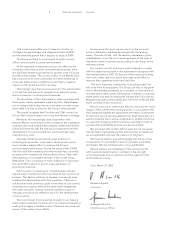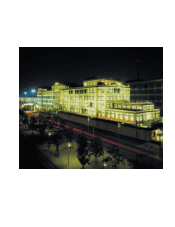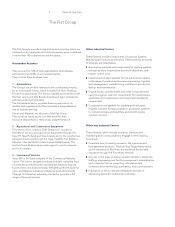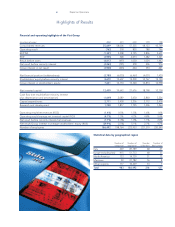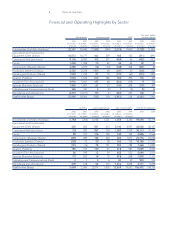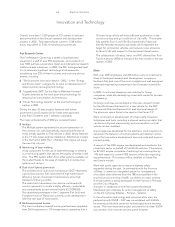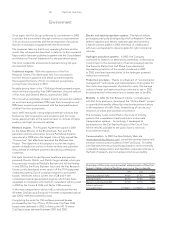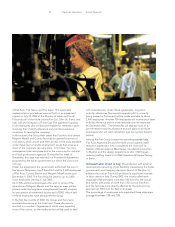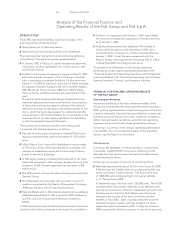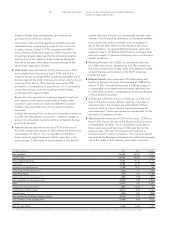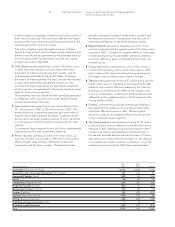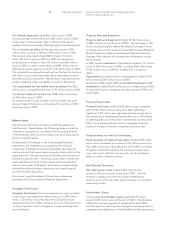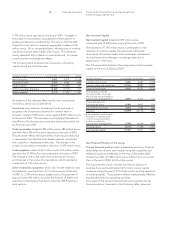Chrysler 2002 Annual Report Download - page 17
Download and view the complete annual report
Please find page 17 of the 2002 Chrysler annual report below. You can navigate through the pages in the report by either clicking on the pages listed below, or by using the keyword search tool below to find specific information within the annual report.
15 Report on Operations
Once again, the Fiat Group confirmed its commitment in 2002
to protect the environment through continuous improvements
in its production processes and the development of products
that are increasingly compatible with the environment.
The measures taken by Fiat Group operating Sectors and the
results they achieved are described in detail in its Environmental
Report, which has been published together with the Consolidated
and Statutory Financial Statements for the past eleven years.
The most noteworthy achievements realized during the year
are reviewed below:
Traditional engines. With the assistance of the Fiat
Research Center, Fiat developed new low consumption
and low emission gasoline and diesel-powered engines
that expand the family of Euro 4-compliant powertrains,
joining those introduced in 2001.
Notable among them is the 1.3 Multijet diesel-powered engine,
which will be produced by Fiat-GM Powertrain, the joint venture
of Fiat Auto and General Motors, starting from 2003.
This innovative, extremely compact engine can even be installed
on small cars and guarantees 10% lower fuel consumption and
50% lower emissions as compared with the best performance
of other Fiat Auto powertrains.
Iveco itself introduced cutting-edge powertrain solutions that
feature low fuel consumption and emissions and low noise
levels, applying them at the industrial level on its lines of heavy,
medium, and light commercial vehicles.
Methane engines. The Program Agreement signed in 2001
by the Italian Ministry of the Environment, Fiat, and the
petroleum industry association (Unione Petrolifera) became
operational in 2002 when the largest cities of Italy signed the
“Convention” that effectively launched the Methane Gas
Project. The objective of this project is to plan the organic
growth of distribution points on Italian territory and subsidize
the purchase of methane-powered vehicles by professional
customers.
Fiat Auto launched its new Bipower (methane and gasoline
powered) Ducato, Doblò, and Doblò Cargo vehicles, which join
the previously introduced Multipla Bipower and will be flanked
in mid-2003 by the Punto Bipower. Iveco and the Fiat Research
Center jointly developed a new version of the 310 horsepower
methane-powered, Euro 4-compliant engine for articulated
busses. Moreover, Iveco’s current line of 2.8 and 9 liter
compressed natural gas-powered engines, which have been
upgraded in compliance with the Euro 4 standard, will be joined
in 2003 by the Cursor 8 CNG and Tector CNG versions.
In the mass transportation sector, Irisbus introduced the new
18-meter CityClass and Europolis 9.4-meter compressed natural
gas (CNG) methane-powered busses.
Completing the order for 150 methane-powered busses
purchased by the City of Turin, 50 18-meter CityClass CNG
busses were delivered in 2002, following the 100 12-meter
CityClass busses delivered between 2001 and 2002.
Electric and hybrid propulsion systems. The hybrid vehicle
prototypes previously developed by the Fiat Research Center
(electric-gasoline and electric-methane gas) were joined by
ahybrid solution added in 2002, the result of collaboration
with Iveco and applied to diesel engines for light commercial
vehicles.
Hydrogen propulsion systems. In 2002, the Company
continued its research on alternative powertrains, confirming its
commitment to the development of fuel cell powered vehicles.
The Seicento Elettra Fuel Cell Phase II was developed,
representing evolution of the model introduced in 2001.
In 2002, simulated operating tests of the hydrogen-powered
Irisbus bus continued.
Production processes. Thanks to refinement of “environmental
management” techniques and implementation of programs for
the continuous improvement of production units, the average
indices of water and waste recycling continued to rise in 2002,
accompanied by further reductions in wastes sent to landfills.
Mobility. In 2002, the Fiat Research Center, in collaboration
with Fiat Auto and Iveco, developed the “Online Fleets” project
to quantify the benefits offered by mobile telecommunications
to the regulation of traffic flows, streamlining of car use, and
reduction of urban and suburban air pollution.
The Company is also committed to the study of mobility
systems that complement traditional public and private
transportation systems. Accordingly, it developed its
participation in the Car Sharing Project of the City of Turin.
All the vehicles available to the public have a minimum
environmental impact.
Communication. In 2002 the New Mobility Web site,
(www.newmobility.fiatauto.com), joined the existing internal and
external communication systems of the Fiat Group. This Web
site illustrates the new principles applicable to environmentally
compatible transportation and describes corporate initiatives in
the field of research, environmental protection and safety.
Overview of the main environmental achievements of the Fiat
Group’s Italian industrial facilities over more than a decade
1991 2001 2002
Water recirculation index 44.6% 67.5% 69.9%
Recycled waste 61.0% 75.4% 77.8%
Waste to controlled landfills 37.0% 10.7% 7.6%
Solvent emissions
from paint shops 144.0g/m277.78g/m277.4g/m2
Environment


